February 5, 2016
Air Date: February 5, 2016
FULL SHOW
SEGMENTS

Great Bear Rainforest Protected From Massive Logging
View the page for this story
Eighty-five percent of the Great Bear Rainforest in British Columbia is now protected from logging, after decades of negotiations among environmental activists, the timber industry, First Nations, and the BC government. Temperate rainforests are one of the most rare ecosystems on Earth.Host Steve Curwood discusses how these groups came together with reporter Andrew MacLeod of the magazine The Tyee, who explains what’s been protected and what’s open for logging. (08:00)
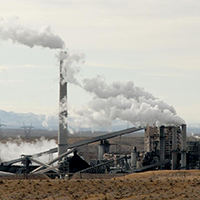
Beyond the Headlines
/ Peter DykstraView the page for this story
Peter Dykstra shares some good news this week with host Steve Curwood. There are large reductions in air pollution costs and less toxins in fish. They also look back at Donald Trump’s battle against Scottish wind power. (03:55)
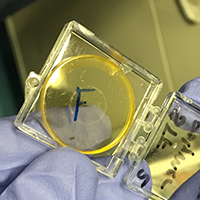
A Novel Way to Capture and Release the Warmth of the Sun
View the page for this story
Storing solar energy is an enduring challenge for scientists, but now a team of MIT researchers has developed a new material that can trap it and release it as heat on demand. Host Steve Curwood visits the MIT lab to hear from postdoc David Zhitomirsky and graduate student Eugene Cho about their material and how it might be used to do such things as defrost windshields and warm our clothes. (11:00)

What's New for Electric Cars
View the page for this story
Gasoline prices are low right now, yet some manufacturers are poised to launch affordable electric cars with a 200 mile range. Host Steve Curwood speaks with green transportation reporter Jim Motavalli about electric cars and the future of renewable sources for electricity-- how Tesla’s Powerwall and a large fleet of electric cars could help stabilize the grid, and add flexibility to our greener energy future. (07:30)
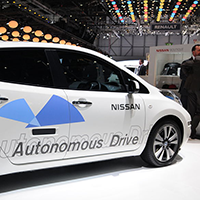
A Vision to End the Hassle of Urban Parking
View the page for this story
Looking for parking in a city is frustrating for the driver, and bad for the climate as circling cars emit unnecessary carbon dioxide. But as reporter Clive Thompson tells host Steve Curwood, fleets of coordinated, self-driving cars could bring an end to parking as we know it and help make our future cheaper, as well as more efficient, pleasant and green. (16:25)
Show Credits and Funders
Show Transcript
HOST: Steve Curwood
GUESTS: Andrew MacLeod, Jim Motavalli, David Zhitomirsky, Eugene Cho, Clive Thompson
REPORTERS: Peter Dykstra
CURWOOD: I'm Steve Curwood. The world of the future; within the next two decades we’ll see a very different landscape on our roads.
MOTAVALLI: I think we're headed towards an all-electric fleet on the road. We've basically reached the point where range is no longer an issue; that's probably the biggest objection. But once you have 200 miles routinely at an affordable price, I think it's inevitable.
CURWOOD: And those electric cars could provide backup power to the electric grid, and may even be driving themselves, so we’ll never need to park them. Also, crafting a new material that will take in and store solar energy, and warm your clothes.
ZHITOMIRSKY: The interesting thing for me was to expand the horizons of what you can do with energy. Instead of just converting light to electricity, now you can convert it to chemical energy and then ultimately release this energy as heat.
CURWOOD: That and more this week, on Living on Earth. Stick around.
[NEWSBREAK MUSIC: Boards Of Canada “Zoetrope” from “In A Beautiful Place Out In The Country” (Warp Records 2000)]
ANNOUNCER: Support for Living on Earth comes from United Technologies – innovating to make the world a better, more sustainable, place to live.
Great Bear Rainforest Protected From Massive Logging
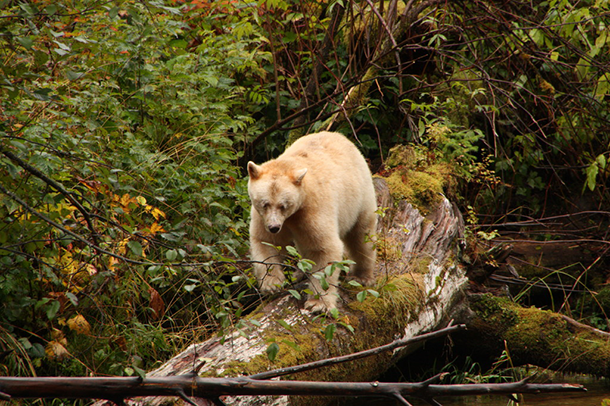
A white spirit bear fishing (Photo: Elsen Poulsen/Animals Asia, Flickr CC BY-NC 2.0)
CURWOOD: From the Jennifer and Ted Stanley studios at the University of Massachusetts Boston and PRI, this is Living on Earth. I’m Steve Curwood. Today’s program is full of good news and visions and dreams of the future, and we start with a deal to preserve a huge swath of rare coastal rainforest. Temperate rainforests make up less than one percent of the world’s forests, and the biggest stretch is along the North Pacific coast from Southern Alaska to northern California. And now after years of negotiations, 85 percent of the Great Bear Rainforest along the coast of British Columbia will be protected, with just 15 percent open for logging. It’s wild and wet there, with giant trees, grizzly bears, gray wolves, salmon, and even the rare and revered white Spirit bear. Industry, First Nations, government and conservationists came together to forge this agreement, and to understand how, we called up Andrew MacLeod, a reporter with the Vancouver-based magazine the Tyee. Andrew, welcome to Living on Earth.
MACLEOD: Thank you for having me on.
CURWOOD: I have to ask you about your magazine name, the Tyee.
MACLEOD: Yeah, so it's kind of salmon. We were set up as an alternative to the mainstream media more than 10 years ago, and the idea is sort of a swimming against the current kind of image.
CURWOOD: Swimming upstream, huh?
MACLEOD: Exactly.
CURWOOD: But not endangered as so many salmon are.
MACLEOD: No, perhaps under threat but no.
CURWOOD: [LAUGHS] So tell me about the Great Bear Rainforest in British Columbia. What's it like to be among the trees and wildlife?
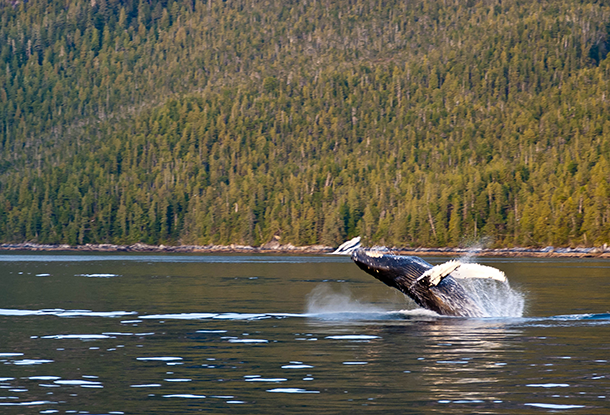
A humpback breaks the surface of the water off British Columbia’s north coast. (Photo: **604*250**, Flickr CC BY-NC 2.0)
MACLEOD: The Great Bear Rainforest, it used be known as the mid-coast timber supply and environmentalists renamed it around 1997 the Great Bear Rainforest and it was the start a campaign to save it. It's an area of 6.5 million hectares between the top end of Vancouver Island and the Alaska Panhandle. So it's an area, about the size of Ireland, and it's quite remote. There are only about 1,400 people who live there. So much of it has never been logged. This is usually described as the largest intact temperate rainforest in the world, very lush, mossy, moist year-round ecosystem. They get something like a meter and a half of rain a year on the coast so big, big trees, Cedars and Firs and Spruce and such.
CURWOOD: And when you say big, big trees, how big are these big trees?
MACLEOD: Yeah, we're talking trees that five or six people put their arms around. Some of these Cedars can be in 20 feet in diameter, that kind of thing. They are big, big trees.
CURWOOD: Andrew tell me what is the Spirit bear?
MCLEOD: They are a subspecies of Black bear. They are a genetic variant that comes out white, so it's a white black bear. There are also Grizzly bears there, there are whales, wolves, and just relatively pristine ecosystem up there.
CURWOOD: And who calls them Spirit bears? Is this a First Nations thing? Is this something that environmental activists had cooked up? What is it?
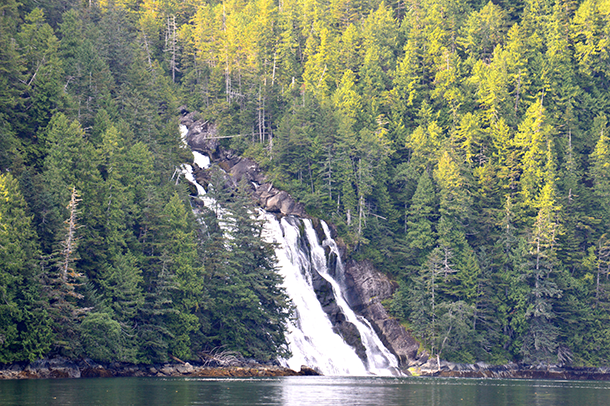
Lizette Falls in the Great Bear Rainforest (Photo: Megan Coughlin, Flickr CC BY-ND 2.0)
MACLEOD: My understanding is that it goes back through the First Nations, there have always been these genetic variant bears there and they're seen as special for sure.
CURWOOD: So what does protecting 85 percent of this forest really mean? What's permitted in the 15 percent that's going to be logged?
MACLEOD: I mean, the way they describe that is working forests, so it's sort of open for logging, same kinds of standards as the rest of the province. The forest industry will tell you that that means protecting viewscapes, it means protecting old-growth, it means protecting habitat for species at risk. In this case, it will mean protecting bear dens. Critics will tell you that the logging industry always says that kind of thing and you know, it will be destructive, damaging to the ecosystem, but on the other hand, the trade-off is that something like 85 percent of the remaining forest is being protected there, so it's a balance.
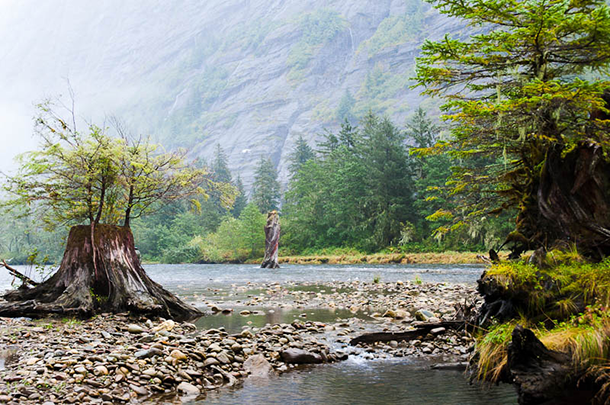
Old stumps in the Great Bear Rainforest (Photo: Heather & Mike, Flickr CC BY-NC-ND 2.0)
CURWOOD: Andrew, what role did the science of ecosystem-based management have in making this plan do you think?
MACLEOD: I mean, that's been part of the talking points from the start was that they were going to apply ecosystem-based management across entire the land-base. Often in BC we're something like 14 percent covered by parks, but a lot of times the parks that they make are the tops of the mountains, it's the rock, it's the ice, it's the places where there isn't a lot of commercial activity, so the idea is that what's protected will be representative of the different ecosystems that are present in the rainforest. Things right down on the coast, the valley bottoms, which is where the big trees grow.
CURWOOD: So how did this agreement come together? Talk to me about the different roadblocks involved in making this work? What, you have industry, you have environmental activists, you have First Nations, the Native American population we would say in the United States, and the government. When we did earlier work on Clayoquet Sound, we understood that the BC government was part of the logging industry and it has an interest in it.
MACLEOD: In the Great Bear as well, BC timber sales is a government company and they are one of the license holders up there. BC is very politically divided. There are a lot of people who working in resource industries who you are all for logging and paving it, and the government for the most part over the history of the province has been involved in encouraging that. And there a lot of people who are here because it's beautiful, right, people who don't directly depend on resource jobs, but are here because they like the place, and there's a very strong and very healthy and environmental movement. I mean, this is the birthplace of Greenpeace, David Suzuki and the Suzuki Foundation are here, Sierra Club is strong, a group called Forest Ethics are involved as well.
There've been fights in BC over land use going back 30 or 40 years. A lot of those fights were sort of valley by valley. Environmentalists sat down and said, well, what's the next big battle and how do we fight in a way that makes sense? And they started a markets campaign, so there are the five main forest companies that hold licenses up there, and they went to their customers and said well, basically, we'll make it uncomfortable for you if you want to take trees from here and then turn them into the toilet paper and books and such. We'll make it clear where they're coming from and what the destruction is like on the land, and so the forest companies had to sit down with them, and there was an initial agreement that was heavily towards protection. First Nations were involved in that as well. They went back to their communities and a lot of the reaction they got was wait a second, we need jobs here as well. They weren't necessarily all for protecting everything, so yeah, we've been looking at 20 years of discussion, 10 years of serious negotiation and involving all kinds parties - 26 First Nations, five logging companies, three environmental groups, provincial government, some local governments. The idea is that they have come to some kind of a balance that everyone can live with.
CURWOOD: Before you go, Andrew, tell me what do you think was the secret sauce that got everybody together at this time? Long-standing conflict, a lot of discussion, finally, a deal.
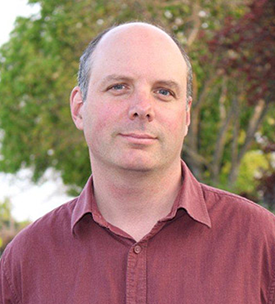
Andrew MacLeod is The Tyee’s legislative bureau chief and lives in Victoria, B.C. (Photo: Annie MacLeod)
MACLEOD: Going back to when it started, I think it was that threat of the markets campaign. Clayoquet Sound, there were something like 700 people arrested there, there were trials, and it gave forest products from British Columbia a bad name. We were the Brazil of the north. I think the logging companies didn't want to go through that again, and then adding to that, First Nations here have seen their rights, we have a history where the powers in Europe sat down and divided up North America, and BC was property of the queen and all that, but there were lots and lots of people already living here. Lots of First Nations people will tell you they've been on the land for thousands and thousands and thousands of years and it's been sustainable, it's been healthy, that it's really only last 150 years of colonialism where you've seen clear-cuts and destruction and species driven to extinction. On the other hand, there are lots of people from First Nations who are working in the logging industry today as well. Over time, First Nations have sort of reestablished their rights. There have been some precedent-setting cases just in the last few years that have recognized aboriginal title does exist. The first sort of iteration of those court rulings was that First Nations people had to be consulted. The government can't just circle parts on a map and say, yeah, that's open for logging any more.
CURWOOD: Andrew MacLeod writes for The Tyee and lives in Victoria, British Columbia. Thanks so much for taking the time today, Andrew.
MACLEOD: Thank you for having me on and thanks for your interest.
Related links:
- ‘Solutions Are Possible’: Great Bear Rainforest Land-Use Deal Reached
- Ecosystem based management in the Great Bear Rainforest
- About the Spirit or Kermode Bear
- Visiting the Great Bear Rainforest
- VIDEO: Explore the Great Bear Rainforest
- VIDEO: Last Stand of the Great Bear from National Geographic
- About Andrew MacLeod
[MUSIC: Magpie, The Land Knows You're There. Living Plane, Long Tail Records]
Beyond the Headlines
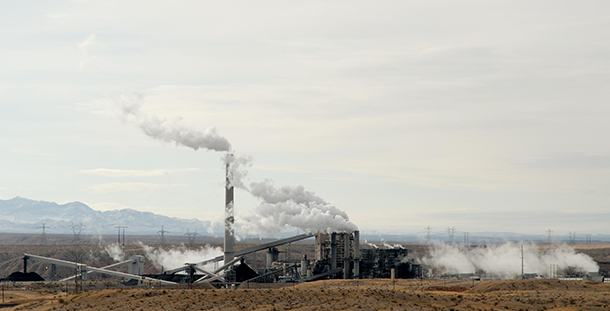
Health and environmental costs attributed to air pollution from U.S. energy production declined from $175 billion a year in 2002 to $131 billion in 2011. (Photo: Thure Johnson, Flickr CC BY-NC-ND 2.0)
CURWOOD: Time to check out what Peter Dykstra has unearthed beyond the headlines now. Peter’s with Environmental Health News – that’s EHN.org and the DailyClimate.org, and is on the line from Conyers, Georgia. Hi, Peter, what have you got?
DYKSTRA: Well, Steve, you know what, I have some good news. There’s a paper from Carnegie-Mellon University that says that in the year 2011 alone, air pollution related to US energy production cost at least $131 billion dollars in health and environmental impacts.
CURWOOD: Uh, wait a second, that’s supposed to be good news?
DYKSTRA: Yeah, it’s good news because that same report placed the costs much higher – at $175 billion – back in 2002. All of this of course is an educated guess, but the researchers tried to tally up the real costs of oil refineries, coal mining, electric generation and oil and gas extraction.
CURWOOD: But I’d think that the growth of domestic oil and gas production from fracking would have driven these numbers up instead of down by 2011?
DYKSTRA: Well bear in mind there were other factors like the economic downturn in 2008, the move away from coal, and there may have been many other things that helped to negate that.
CURWOOD: Hmm…Well, what do you have next for us?
DYKSTRA: Dare I bring a little more good news?
CURWOOD: By all means, please.
DYKSTRA: There’s a study from the Scripps Oceanographic Institute that says levels of potential carcinogens like mercury, DDT, and PCBs are at their lowest levels in 40 years in ocean fish.
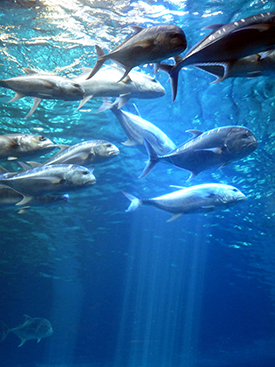
A new study finds that levels of toxins in ocean fish—like mercury, DDT, and PCBs—are at their lowest levels in 40 years. (Photo: Magalie L’Abbé, Flickr CC BY-NC 2.0)
CURWOOD: Whoa, how did that happen?
DYKSTRA: The Scripps researchers pointed out what might be obvious: stronger laws, public pressure, and better corporate conduct – whether that was voluntary or otherwise – they’ve all helped to bring about some positive news.
CURWOOD: But is all this fishy news all positive?
DYKSTRA: That’s a good one, Steve, all positive news in an environmental show. The Scripps researchers warn that many wild fish are still unsafe for human consumption – that’s no surprise. But they also said that smaller fish, often presumed to be safer than the fish at the top of the food chain, may in some cases be no safer at all.
CURWOOD: Hmmm, well, hey what do you have from the History vaults this week?
DYKSTRA: Well, were into the political season big time now, and four years ago this week, Donald Trump faced off with Scotland and their battle over a wind farm hit a fever pitch. Trump was livid over a proposal for 11 wind turbines to be built offshore from his billion-dollar golf resort near Aberdeen.
He said Scotland’s First Minister (that’s sort of the CEO of Scotland), Alex Salmond “Would be remembered for centuries as the man who destroyed Scotland.”
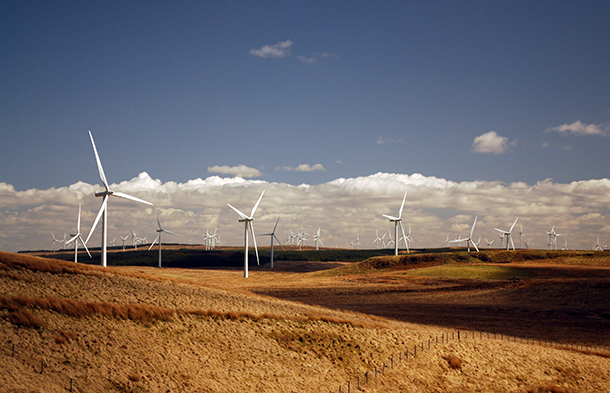
Whitelee Wind Farm—the largest onshore wind farm in Scotland—is part of Scotland’s fastest growing renewable energy sector. (Photo: ms.akr, Flickr CC BY 2.0)
CURWOOD: Rather like those various English kings and generals, huh?
DYKSTRA: Correct, and Trump might have fancied himself as Braveheart, defending Scotland by tilting at the threat of the windmills. Anyway, Trump waged a no-holds-barred court battle against the menace of wind power, which he saw as an environmental scourge that would taint the beauty of the golf course he had been plowing into the Scottish countryside. With two final court defeats last year, the Trump battle against Scotland is over, and Scotland won.
CURWOOD: And by the way, where do things stand now with the golf course and the wind farm?
DYKSTRA: I’m sure many of our listeners will be pleased to know that the golf course is open, and greens fees are about $220 for 18 holes – discounts are available if you’re a loser. And yes, he named the gold course after himself, it’s the Trump International Golf Links. As for the wind farm, it’s still several years off.
CURWOOD: And everyone has moved on?
DYKSTRA: Not before Alex Salmond tore a page from the Trump playbook and called The Donald a “three time loser” for his string of legal defeats. Trump responded by calling the now-Former First Minister a “has-been”, which is technically correct because he has-been out of office for almost two years. And when the UK Parliament threatened to ban Trump over his anti-Islamic comments, Trump threatened to pull out of the golf project entirely.
CURWOOD: You know, I always thought that someone was always supposed to take the high road in Scotland.
DYKSTRA: Everybody is taking the low road on this one.
CURWOOD: Peter Dykstra is with Environmental Health News, that’s ehn.org and theDailyClimate.org. Talk to you soon, Peter!
DYKSTRA: Alright, Steve. Thanks a lot, we’ll talk to you soon.
Related links:
- The staggering economic cost of air pollution
- Fish toxins at lowest levels in decades
- Mapping Scotland’s Disgust With Donald Trump
- Video: Donald Trump loses appeal against windfarm near Scottish golf course
[MUSIC: Loch Lomond, The Highland Connection, Scottish Traditional, Ridge Records]
CURWOOD: And there’s more on these stories on our website, LOE.org. Just ahead...plugging into the cars of the future. Stay tuned to Living on Earth.
[CUTAWAY MUSIC: The Punch Brothers, Brandenburg Concerto No 3 Allegro, Live from the Lower East Side, It's p-Bingo Night, Nonesuch]
A Novel Way to Capture and Release the Warmth of the Sun

The solar heat-storing material is a thin, yellowish-orange film. (Photo: Steve Curwood)
CURWOOD: It’s Living on Earth, I’m Steve Curwood. If you drive in the colder climes, on many mornings you need to scrape your windshield clear of ice. But you can de-ice the back window with just the push of a button. That’s because it's illegal to put anything in windshield glass that could block the driver’s view, such as heating wires. But now a team of researchers at MIT has come up with a chemical that would let windshield glass directly store solar energy and then release it on demand as heat to melt the ice.
This chemical stores and releases energy by changing shape and could be very useful in electric cars that don’t have engine heat for defrosting. And the same chemical could be woven into clothing fibers to capture the sun’s energy and then give you some added warmth when you ask for it, even days later. I paid a visit to the lab where the MIT team has been working on this breakthrough and met up with researchers David Zhitomirsky and Eugene Cho, who work in the lab of professor Jeffrey Grossman.
[SOUNDS OF THE LAB]
Hi, David. Hi, Eugene.
ZHITOMIRSKY: Thanks.
CHO: Hello.

In the early stages of research, the solar heat material proved difficult to deposit as a uniform film and crumbled away at the edges. (Photo: Steve Curwood)
CURWOOD: Let's go to the basics here, David. Now, most people, when they think of collecting solar energy, they think of converting it to electricity, but this is a chemical process. Tell me what you do.
ZHITOMIRSKY: So yes, it is quite different from solar cells where you absorb light and convert it to an electrical charge. In this case, what we do is we use these molecules that can absorb UV light and instead of generating charges, what they do is that they change shape, and by changing shape, they can store chemical energy this way.
CURWOOD: OK, so sunlight hits this molecule, it changes shape and can storage its energy. And how do you get the energy out?
ZHITOMIRSKY: So you can figure the material in several ways. One way is to add a small amount of heat, and the material will release more heat than you add in. The other methods are triggering it with light or you can apply an electrical field to the material.
CURWOOD: What made you think that it would be possible to do this?
ZHITOMIRSKY: The field of these kind of fuels is not new. What is novel here is their obligation in solid-state that enables them to be utilized in consumer goods. And so we chose a molecule that was already known to be stable and that had this kind of behavior, but the key was to employ it in solid state and make very nice and uniform films.

From left to right: graduate student Eugene Cho and postdoc David Zhitomirsky in the MIT lab. (Photo: Steve Curwood)
CURWOOD: OK. Introduce me to your molecule please, and let me get my mouth ready for the pronouncer.
ZHITOMIRSKY: So the molecule is called azobenzene.
CURWOOD: Azobenzene. That's not so hard to say.
ZHITOMIRSKY: Yep. And basically we take this azobenzene and we will polymerize it, meaning we link up units of azobenzenes together and that enables us to make very nice films.
CURWOOD: So if you can make a film, how transparent might this film be?
ZHITOMIRSKY: Right now it has a yellowish orange tinge, but in principle we have simulations that show that you can actually tailor the film to be fully transparent, and invisible.
CURWOOD: So, what were the big challenges of getting this to work? You understood the scientific principles here, but you we're looking to cut the costs and make it simple.
ZHITOMIRSKY: Yes, exactly. So, one of the directions that things moved in before I joined this group was putting these molecules on carbon nanotubes in order to improve their properties. And so that's expensive inherently because you need carbon nanotubes, and the solubility of the material wasn't very high. I come from a background in nanocrystals and we were using these nanocrystals back in Canada, Toronto, to absorb photons and convert them to electricity, so it was basically solar cell technology, and the idea there was to make a paint, a solar paint that you would simply put on a substrate and it would make everything much more inexpensive. This polymer that we have right now is also essentially a paint. You can deposit it directly from solution. The interesting thing for me was to expand the horizons of what you can do with energy instead of just converting light to electricity, now you can convert it to chemical energy and then ultimately release this energy as heat.

The team often works out chemical reactions on fume hood glass in the lab. (Photo: Steve Curwood)
CURWOOD: Whose idea was this?
ZHITOMIRSKY: It was a collective meeting between my supervisor and I and Eugene, and we just sort of sat there and we thought how could we make something that people were actually going to care about and this came out of it.
CURWOOD: Eugene Cho, you're a graduate student at MIT. Gene, why are you excited to work on this project?
CHO: It was a lot different from other research before because before when I joined back in 2012 what was big was solar panels. But everybody was working on that. I wanted to do something slightly different from the conventional solar panel industry and when I talked to Jeff he suggested this project where there's molecules, not large panels, that could absorb the sunlight and reuse it in different applications, in this case in the form of heat.
CURWOOD: So here we are in your laboratory at MIT. Give us a tour. Show us the machines and the material here. What's what?
ZHITOMIRSKY: So this is the fume hood, and we work in it because of toxic materials.
CURWOOD: How toxic is this stuff?
ZHITOMIRSKY: In small molecule form it's somewhat toxic, but as soon as you make a polymer out of it and that's another advantage - it suddenly becomes not so toxic at all. So in here we have things like pumps in order to evacuate containers of solvents because we need to dry things off. We have scales to weigh things out. We have all sorts of solvents in order to separate things out. We have some vacuum lines and nitrogen lines. This is called the Schlenk line.
CURWOOD: And what you have scribbled here on the window?
ZHITOMIRSKY: Sometimes we just write chemical equations and how we engineer these materials directly onto the glass.
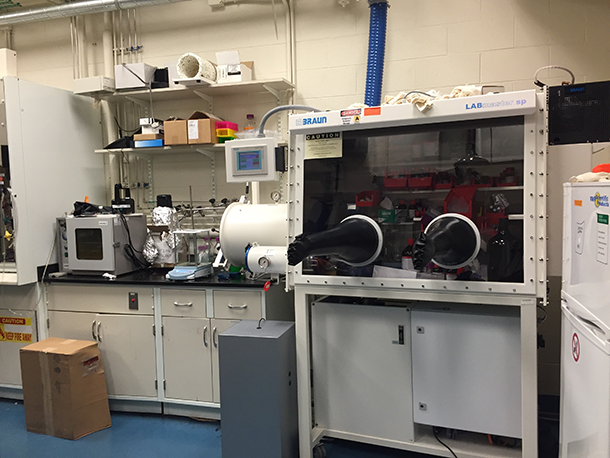
A vacuum hood allows MIT researchers to safely work with toxic materials needed to make this film. (Photo: Steve Curwood)
CURWOOD: [LAUGHS] So what we have here?
[SOUNDS OF OPENING DRAWER]
ZHITOMIRSKY: So, here we have a film right on top of a glass substrate as you can see. It has an orange or yellow tinge, and this is actually an example of what a type of film we'd make to do also all sorts of investigations for heat release.
CURWOOD: Well, that's pretty clear. There's a little bit of yellow-orange around the edge there, but if you look through it it's...a pair of sunglasses would cut out more light like that. Now, I understand one of the applications for this might be in the windshield of the car, to de-ice a car. How would that work?
ZHITOMIRSKY: What you would do is you put this material inside of the windshield and when you wanted to de-ice the windshield you would hit a button and it would trigger the material to release any energy that it has stored. And the idea is to melt the layer of ice right between main layer of ice and the windshield itself. So you're not actually melting all the ice, just a thin sheet of it, and you can remove it with a windshield wiper for example.
CURWOOD: It would just slide right off. So what's your best guess as to how you get from the yellow, the yellowish orange, to something that's really completely transparent, translucent?
ZHITOMIRSKY: The reason this molecule results in a yellow film is because it absorbs along parts of the visible spectrum, and what you can do is you can attach different types of functional groups onto the molecule and this will shift the absorption spectra around.
CURWOOD: People are very interested in this, I gather, because in electric cars you use a lot of energy to do something like de-ice or heat the car.
ZHITOMIRSKY: Exactly, yes, now instead of running electricity through metal wires or the metal screen, you simply employed energy that you get for free just by absorbing sunlight.
CURWOOD: By the way how much energy is used in an electric car for things like de-icing the windshield or heating the people?
ZHITOMIRSKY: We've estimated approximately 30 percent, so this kind of technology will certainly be able to make a dramatic impact on electric vehicles.
CURWOOD: Now, one thing that I'm really intrigued about is the notion of heating clothes. So if I walk outside on a sunny day and my clothing get some energy in it and then later when it's colder I could just hit a button and it'll keep me warm like an electric blanket?
ZHITOMIRSKY: So, this is one of the applications that is closer to the market because you can feel as much as two degrees or three or maybe five degrees, and this is achievable today with these materials. The way we envision using it is to integrate into fibers that you then make clothing out of, or what you can do is just take a separate sheet of the stuff, and in certain cases it might be appropriate to just attach a sheet of the stuff onto the clothing itself.
CURWOOD: So this could be like an updated blanket or sheet. Hang the sheet outside, it gathers all this energy and have it at night and then if it's a little cold, hit a switch and I've got something a little bit warmer.
ZHITOMIRSKY: Yes, exactly, you could use it as a solar blanket, for sure, and it might be much more appropriate for places that don't have an electrical outlet, for example, if you're camping or especially in third world countries where they don't necessarily always have access to electricity, this would be quite useful to staying warm at night.
CURWOOD: So, there I am on my expedition with my solar blanket. What would release the heat?
ZHITOMIRSKY: So you have to have a system that can trigger this material and a simple one might be carrying around a blue LED with you that could just get this process going.
CURWOOD: So you zap it with more light and it says oooh, I'm free now.

Host Steve Curwood, left, in the MIT lab with Eugene Cho, center, and David Zhitomirsky, right. (Photo: Helen Palmer)
ZHITOMIRSKY: Exactly, use a different wavelength of light and you could trigger it that way.
CURWOOD: That could be a problem. You're walking down the street and someone happens to have one of those things, and ohhh, I'm feeling a little warm now.
ZHITOMIRSKY: Yeah, that's certainly one thing to get around, making sure that this material is only exposed to the right kind of radiation at the appropriate time.
CURWOOD: OK, this sounds great in theory, but is it affordable to put it in something like clothes or a windshield?
ZHITOMIRSKY: So that process itself is very simple. It takes two synthesis steps to make the material itself and you can make it in a on a very large-scale, on kilogram scale. We've easily scaled our stuff up to grams, and as far as the cost of the actual material, it's actually quite low.
CURWOOD: Now, you are a graduate student, Eugene, so what's your thesis going to be about?
CHO: Hopefully to get these molecules to work!
CURWOOD: [LAUGHS] Let's go forward 10 or 20 years. How do you think this work will have been applied in the coming years?
CHO: Well, I guess with this it could expand into, with high-energy density store, be a stovetop or used to de-ice like pipes types in bigger scales rather than just windshields. Larger applications I guess.
CURWOOD: So how long before we see this coming to market?
ZHITOMIRSKY: I would say that it is possible somebody will pick this up as a startup fairly soon, maybe in a length's scale of a year or two because there's things you can do with these materials right now.
CURWOOD: David Zhitomirsky is a Banting Fellow post-doc associate. Eugene Cho is a master's student at the Massachusetts Institute of Technology working on solar thermal fuels with MIT professor Jeff Grossman. Gentleman, thanks so much for taking the time to show us around your lab.
ZHITOMIRSKY: Thank you very much.
CHO: Thank you.
Related links:
- A new way to store solar heat
- Journal article, “Solid-State Solar Thermal Fuels for Heat Release Applications”
- Molecular switching, explained
- About spray-on solar cell paint
[MUSIC: Lily Frost, It's Too Hot For Words, Too Hot For Words, Marquis Classic]
What's New for Electric Cars
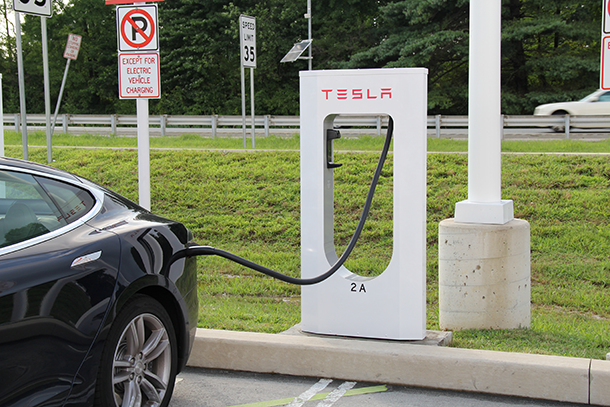
Networks of Tesla Supercharger Stations will help to encourage people with “range anxiety” to purchase all-electric vehicles like the Model 3. (Photo: Jeff Cooper, Wikimedia Commons CC BY 2.0)
CURWOOD: Back in 2011 when gasoline prices in the US were close to $4 a gallon, President Obama called for a million electric cars on the road in America by 2015. But so far Americans have only bought 400,000 EVs — less than half that goal. Range and price seem to be much of the problem — a $30,000 electric car barely goes 100 miles on a charge—even less if it’s cold. And if you want to go 300 miles on a charge, you have shell out $100,000 for a Tesla. But that’s about to change. Tesla and General Motors both say they will soon sell electric cars that will go 200 miles on a single charge for about $35,000. The Tesla is called Model three and the Chevy is called the Bolt. We called up green car expert and journalist Jim Motavalli to get the latest scoop on EVs. Welcome to Living on Earth, Jim.
MOTAVALLI: It’s great to be on, Steve.
CURWOOD: So, we’ve just had the Detroit auto show. What stood out to you? How green were the cars?
MOTAVALLI: Well, it's interesting. What's happening is the automakers are starting to put out plug-in versions of their cars just sort of as a matter of course, and I'm talking about mostly plug-in hybrids with maybe 30 to 40 miles of all-electric range and they're not making a big deal out of it. It's just becoming part of the background.
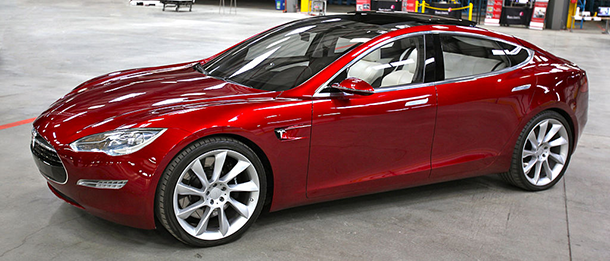
The upcoming Tesla Model 3 is predicted to be a scaled down version of the Model S, priced around $35k and with a range of 200 miles per battery charge. (Photo: Steve Jurvetson, Wikimedia Commons CC BY 2.0)
CURWOOD: Aha. Hey, which of those plug-in hybrids did you like?
MOTAVALLI: Well, I liked a lot of them. I think the Audi A3 is a really exciting car. There is going to be a plug in hybrid version of the Volvo S90. I was very excited by seeing the Chevy Bolt. I've been waiting for that for quite a while.
CURWOOD: I want to be sure I heard you correctly. You said Chevy Bolt, B as in boy not V as in volt.
MOTAVALLI: Exactly. B as in bolt is the companion car to the Chevy Volt. It is a all-electric battery car with 200 miles of range and a price around $35,000, that's after federal incentives probably.
CURWOOD: Well that's cheap.
MOTAVALLI: Yeah, yeah. See what happened is Tesla drew a line in the sand and said it was going come out with its Model 3 and that would be a 200 mile range car for about $35,000, so GM looked at that and said,“well we can beat them the market.”and essentially that's what's happened. The model 3 will be shown next month.
CURWOOD: Tell me about the model 3 that Tesla has announced its going to have and how is this different from the other electric vehicles we've already seen in Tesla's own very pricey hundred thousand dollar mobile?

The Tesla Powerwall is a battery array that can be charged with energy from renewable power. It contains the same battery that will likely be in the Model 3. Together, Tesla and SolarCity are working to capture and store solar energy that could be used to power a home or an electric vehicle. (Photo: Tesla Motors - Tesla Energy, Wikimedia Commons CC BY 4.0)
MOTAVALLI: Well, Tesla is the king of range. People always complain they have what's called range anxiety about electric vehicles. When they came out with the Model S and it had up to 300 miles of range, people were knocked out about that, and of course you had to pay for it. What's interesting was they initially saw the Model S with a range of batteries like 40 kilowatt hours and 60 kilowatt hours and 85 kilowatt hours, and they thought that people who wanted a budget car would go for the one that was 40 kilowatt hour battery with less range. They didn't, so we'll see if 200 miles is a sweet spot for people, but can Tesla make money with a $35,000 car with a 200-mile range? That's a real challenge. On the other hand I would also say that I think a lot of people would want the Tesla because they've been priced out of the Tesla market and now they can get into it for a lot less money.
CURWOOD: Let's talk about the charging apparatus for these vehicles. To what extent will the new Tesla Model 3 be able to connect the vehicle to the grid? What about things like wireless charging?
MOTAVALLI: I would guess that it's going to have wireless charging. I think Elon Musk is interested in that. But one thing it will definitely have is the ability to connect to Tesla's supercharger network. Stations across the country that are 480 volts and can basically fill the car up in about half an hour.
CURWOOD: Now, other countries, I'm thinking of China, I'm thinking of India, they have air quality issues. So as I understand it, China's building up its own electric vehicle capabilities with inexpensive cars. How does that compare to what Tesla and the others have on the market?
MOTAVALLI: Well, Tesla has gone into China in a fairly big way but it's found it challenging to say the least. There are a lot of companies in China building electric cars for the domestic market but none of them have very big sales yet. The Chinese government has really committed itself to a big push to electrify the country's vehicle fleet, but it hasn't been acting very quickly to make sure that happens. The problem is there's not much of a charging network and it's an extremely large country. Most people, maybe 90 percent in the US charge at home, but in China people don't live in suburban communities with garages. They live an apartment buildings, so charging at home is not likely to happen, and there's got to be a really robust charging network both at your community, maybe your apartment building would have a garage and your workplace would have charging and there would be public chargers in every major city. That is far from happening in China.
CURWOOD: You mentioned charging electric vehicles at home, of course, Tesla has come out with what they call the power wall, that's a battery array to be used at home. What do you think of that development?
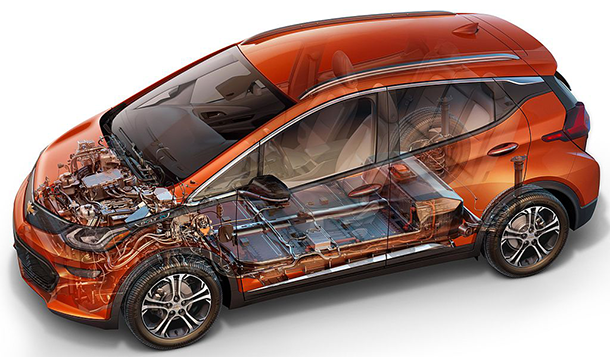
The Chevy Bolt is the all electric companion car to the Volt and thought to rival the Tesla Model 3. (Photo: GM, Wikimedia Commons CC BY-SA 3.0)
MOTAVALLI: I think that's a really interesting development, and it makes total sense for Tesla and its close relationship with a company called SolarCity. The batteries in the power wall are just the same as the batteries in the Tesla cars and can serve as backup for the solar panels from SolarCity. So there's a total sort of circular loop there and synergy, so the product makes complete sense and we've long been talking about how the grid will need battery back-up, but the device - it's a little bit expensive at $7,000 - so essentially it's a seven kilowatt-hour battery array that you'd have in your house.
CURWOOD: So what about the notion of using the electric car as well as, say, a power wall, to support a household? I mean, you can store a lot of electricity and use it in a very flexible way.
MOTAVALLI: That's taking off in a pretty interesting way. We have vehicle to grid communications which is what you're talking about and essentially the car can be a rolling battery depository that can plug into the grid and in times of peak power demand can return power to the grid, and if just one electric car does that, it's not a big deal but if you have say 100 of them, all with like 40 kilowatt hour batteries connected to a smart utility that is able to turn on their batteries when it needs them, and then doesn't have to turn on, say, a backup generator or what might be a coal power plant that is in reserve, and the vehicles will still end up being charged when their owners get into them and people will get paid for that, it has the potential to be a pretty good load leveler on the grid.
CURWOOD: Give me some blue-sky thinking. Where will we be in five or 10 years as far as the car energy markets are, in your view?
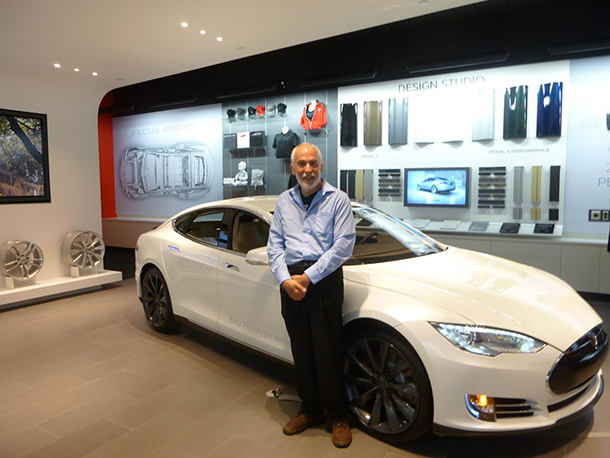
Jim Motavalli next to the Model S (Photo: courtesy of Jim Motavalli)
MOTAVALLI: I think we're moving away totally from fossil fuels. I think we're headed towards an all-electric fleet on the road. We've basically reached the point where range is no longer an issue - that's probably the biggest objection - but once you have 200 miles routinely an affordable price I think it's inevitable, and I think at the same time we are also heading for a renewable energy grid. It's going to be hard to make it work, but I think we'll have an international effort to make that happen.
CURWOOD: Jim Motavalli is an environmental writer who specializes in green transportation. His new book is called High Voltage. Jim, thanks so much for taking the time with us today.
MOTAVALLI: Great to be on with you. Always a pleasure, Steve.
CURWOOD: By the way, SolarCity is an underwriter of Living on Earth, but has no input or editorial say in the program.
Related links:
- Everything We Know About Tesla’s Secret Model 3...And Model Y
- Electric Vehicle Incentives by State
- More about Tesla’s Powerwall
- In India, government aid helps carmakers go green and cheap to fight smog crisis
- The Grid-Integrated Vehicle with Vehicle to Grid Technology
- The Supreme Court saves the smart grid, but more battles loom
- Tesla CEO: Oil Price Will Slow Electric Cars; China Course Charted
- A Chinese start-up says its 1000-horsepower electric car has “augmented reality views”
- VIDEO: Tesla Reveals the Powerwall
- Elon Musk on Tesla and solar in Hong Kong and China
[MUSIC: Donovan, Mello Yellow, Donovan's Greatest Hits, Epic]
CURWOOD: Coming up...a vision of a future city without one of its major hassles – parking! That's just ahead on Living on Earth. Stay tuned.
ANNOUNCER: Funding for Living on Earth comes from United Technologies, a provider to the aerospace and building systems industries worldwide. UTC Building & Industrial Systems, provide building technologies and supplies container refrigeration systems that transport and preserve food and medicine with brands such as Otis, Carrier, Chubb, Edwards and Kidde. This is PRI, Public Radio International.
[CUTAWAY MUSIC: Baka Beyond, Soiridh Leis, Journey Between Rykodisc]
A Vision to End the Hassle of Urban Parking

Fleets of autonomous cars might one day bring about the need for large parking lots, particularly in cities. (Photo: Norbert Aepli, Wikimedia Commons CC BY 3.0)
CURWOOD: It's Living on Earth, I'm Steve Curwood. We've all been there, heading to the mall or the theater or dinner, and it ends up taking longer to find a parking space than it did to get there in the first place. This isn't just frustrating; it turns out all these cars driving in circles are bad for the climate, and bad for the air we breathe. But writer Clive Thompson thinks that one of the answers to this parking problem is not so far in the future - self-driving cars. His new essay in Mother Jones magazine is called No Parking Here, and he joins us now to discuss it. Welcome to Living on Earth, Clive.
THOMPSON: Good to be here.
CURWOOD: Clive, you say the average automobile spends the majority of its time sitting still, so if every driver is, say, sleeping the eight hours out of every 24-hour period and presumably not parking, that's a lot of time in parking spaces. Tell me about the math.

Traffic congestion in major cities like Moscow exacerbates the impact that car emissions have on climate change. (Photo: Nevermind2, Wikimedia Commons CC BY-SA 3.0)
THOMPSON: I mean the math is pretty crazy. Your car spends 95 percent of its time sitting in one place. And here is the real problem is that you've got your car at home and it does, it mostly just sits there, and then you drive it for a very brief time to work, and it has to find a place to sit there, right, and then maybe you drive it a very brief time out to dinner, but it has to have a place to sit there, and then you drive back home. In each place where the car is sitting, there needs to be parking, and this becomes an interesting geometric problem, to accommodate the amount of time those cars sit there, our society had to build way more parking than there are cars, right? And the upshot is, you know, there about 250 million cars and passenger trucks, light trucks, in the country. But the estimates are there are close to a billion parking spots. I calculated the square footage, square mileage and it's basically about the size of Connecticut is how much parking we have in the US, and there are all sorts of problems that stem from that amount of parking. I guess on just an aesthetic level parking is pretty ugly. I was talking to one architect during the story who said,“there are a lot of books are like the 10 best buildings in America or the 10 best bridges in America. There is no book of the 10 best parking lots in America because they're just ugly as sin, right?”So, they are ugly, they produce a lot of runoff, you know, like a big rain hits this massive parking lot, water's got nowhere to go so it rushes at the edges and it just rips the topsoil off of whatever field it encounters. So it causes these environmental problems.
CURWOOD: But but wait a second. If an average vehicle is parked most of the time with the motor turned off isn't that an environmental benefit? The thing isn't running?

Diagram of example parking lot layout with angle parking as seen from above. White arrows show direction of allowed travel in each lane (for right-hand-drive countries). Several parking spaces closest to the building entrance are reserved for the handicapped. Cars of various colors are shown parked in some of the spaces. The obtusely pointed end indicates the front end of each car. (Photo: H. Padleckas, Wikimedia Commons CC BY-SA 2.5)
THOMPSON: You would hope so, but the problem is that actually parking lots encourage excessive driving because when people go to park in a city they have trouble sometimes finding a parking spot, right, because there's this congestion in the city and so people will sort of circle around looking for parking and studies show that it dramatically increases the amount of time we spend driving. In fact, in my neighborhood in Brooklyn, they did a study that found if you see cars driving past you - standing on the corner see cars driving past you - 30 to 60 percent of those cars are circling looking for parking. They're not going anywhere, they're no longer transferring people from point A to point B, they're now just circling, and so what this means in the city, an enormous percentage of the a carbon being put out by cars isn't getting people anywhere, it's just looking for parking.
CURWOOD: And in your article you say that the death of the ubiquitous parking space is maybe on its way thanks to self-driving cars?
THOMPSON: Yes, there are some interesting trends afoot here. So here's the thing about self-driving cars is that it's likely that by the time these things get fully licensed to be on the road which is in 15, maybe 10, 15, 20 years now, they will probably be deployed not individually - like it probably won't be you or me buying a self-driving car - it'll be probably mostly fleets, right. So, your local taxi company will just buy 200 self-driving cars, or the city might decide that it's going to create a kind of a public transit thing with cars. They'll buy thousands of self-driving cars. Uber and Lyft, they are actively researching to build their own self-driving cars, so the theory is that actually self-driving cars will mostly be fleet-based, and this will be quite interesting because you get a fleet of self-driving cars servicing a large or midsized town and what you'd effectively have is a world where you need to go somewhere, you pull up your phone and you say, I need a car, and the car sort of comes zipping right up to you and maybe there's somebody already in it – like it's intelligent carpooling, they're kind of going in the same direction as you, you guys are to split the costs, this is going to cost you almost nothing because you're sharing the cost - and so you'll still be taking cars all day long but they won't be cars you own. They'll just be those fleets that are incredibly easy to get because it just so many them out there running around. And the thing with those cars is that they are not going need to park ever. They will basically be just be driving and driving and driving around, ferrying people around in this very intelligent, efficient way. So this is the vision.
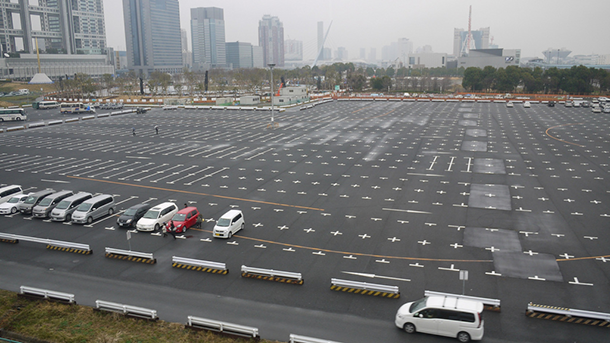
Parking lots in cities take up valuable real estate and add to the heat island effect. (Photo: Antonio Silveira, Flickr CC BY 2.0)
I was surprised by this as I had thought that people were going to buy their own self-driving cars. But over and over again, the experts I talked to, the urban planning experts, the car experts, they see this as the legit...and it's sort of makes sense when you think about it because the truth is owning a car is expensive. You've got to find somewhere to put it, you've got to pay for these repairs, and young people are buying far fewer cars than you expect at their age. They are driving personally far fewer miles that you'd expect at their age, and they're in fact actually even less likely significantly to have their driver’s licenses. So this is a cultural shift, which is also very interesting. So that's kind of a one-two punch that's moving us towards the end of parking. Self-driving cars and a generation of people that actually are less interested in owning their own car.
CURWOOD: So what happens to the ability to hang one's own personal set of dice from the mirror of the car...
THOMPSON: [LAUGHS]
CURWOOD: And then, you know, and let's face it. For older folks, you know, teenagers remember that when you got that license that it was helpful in the dating game.
THOMPSON: Yeah, this is a really interesting cultural shift. I'm 47 and in my generation, I grew up in suburban Toronto, and you still...we have a pretty good subway and bus system but you still needed to get your drivers license for a certain level of autonomy and freedom because if you wanted to kind of move around in the suburbs, you needed to be able to drive, get your family's car, take someone out on a date. So I definitely grew up with the thing that the boomers grew up with, which is the association that the car was kind of right of passage. It was you becoming a little more adult and having some autonomy and independence. That experience is far less common for young people. It's not gone. If you live in a rural area you still really need a car to get around, but more and more, younger people are living in more densely packed areas and they're discovering that in those situations they can really move around pretty easily without driving. The other thing about young people is that's pushing away from driving is that they like using their phones. For them, autonomy is about having a phone, being able to communicate all day long, when they want to, and you can't use your phone while you're driving. Those are rival activities, and they would rather use the phone than drive.
CURWOOD: Hey, so what was your experience been like in a self-driving car?

Subterranean parking lots, like this one in a Brazilian shopping mall, can save limited urban real estate but are expensive to construct. (Photo: Rachmaninoff, Wikimedia Commons CC BY-SA 4.0)
THOMPSON: It was very interesting. So, I get inside this self-driving car in the parking lot of Google, and I'm in the back seat. In the front seat there's an engineer in the driver's seat not touching the wheel. The car starts driving off and I'm looking at the front wheel and basically it's as if a ghost is driving it. The wheel is turning itself. At first it was...for the first like three of four minutes it's pretty unsettling because it really feels weird to have no one, no human driving that car, but it quickly became kind of boring because it turns out that Google's cars are very defensive drivers. And so we'd be driving along and going along fairly fast but the instant someone starts to edge out into our lane, our car would immediately slow down and give way. So, in one sense it actually very quickly became boring and at first I thought, well, this is going be hard. I'm trying to write a story. It's supposed to be exciting. But I became convinced that boring is what you want. When it comes to driving, you want driving to be predictable and safe and boring.
The one thing that most computer scientists and urban traffic experts say that will make them even safer is that if there's actually a lot of them on the road because if all the cars are robotic and if they can talk to each other, well then they can start to optimize for good behavior and minimize bad behavior. They aren't going to make any stupid calls, but they're not going to make any emotional decisions. You can even do things...this is pretty funny...there's a guy at the University of Austin who has done these modelings where, he says, you know, if you have all robot cars on the road, maybe you need stop signs because the cars can just sort of weave through each other right? They can just go right into the intersection and just go right through and slow down and speed up to avoid other cars. And he's done these little animations to show what it looks like, and it's just wild. And the upside is the traffic really keeps moving. So one of the other weird upsides of self-driving cars is that we could actually move around a lot more quickly and efficiently which again reduces emissions because there's a huge amount of emissions that come from a car slowing down and then speeding up again at an intersection.

Parking spaces in front of small shops are being repurposed as “parklets” in cities like San Francisco. (Photo: Mark Hogan, Flickr CC BY-SA 2.0)
CURWOOD: So, one big benefit from self-driving cars would be to eliminate essentially parking spaces for vehicles. So what do you do with all that land that becomes available now?
THOMPSON: It's a super interesting question. I mean most downtown cores are about 31 percent parking right? So think about that. That's prime land. So what would we do if we freed up 31 percent fresh land to do something? What would you do it? Well, maybe the city could finally do some of the things we've always want to do and we can build more housing. Housing in markets, certainly in overheated markets like San Francisco, Chicago, Boston, New York, desperate for more housing, or you can convert some of it to parks.
I mean there's this little parklet program in San Francisco - it's a real blast - where they they let a merchant if you want to - if you've got a coffee shop - you can pay the city a certain amount per year for the parking spot in front of your café and you're allowed to turn it into a park. And so there's all these funny little beautiful parks where they've grassed it over, put in maybe like a little tree and stuff or they maybe put up a bench and there's kind of a sitting area and if you were able to make it green, if you could throw in plants, throw in grass in that area, you could also cool cities down because all that 31 percent it's all asphalt and that heats up cities, what they call the urban heat island effect. Sun hits the asphalt, heats it up, it's like a battery storing heat, sun goes down, it keeps a city hot at night. Well, if you have grass and trees it doesn't do that, it's cools things down a lot. That would make it way more fun and livable and again have fantastic environmental effects because now you're doing much less air-conditioning using less electricity for air-conditioning, so you know the sort of fun things that begin to cascade out of getting rid of parking. It's delightful. There's all these different layers.
CURWOOD: Yeah on the real estate side, you could even take it to the bank. Famously here in Boston a couple years ago there was an auction of two rare tandem parking spaces. In other words, front to back, behind a building on Commonwealth Avenue in the ritzy Back Bay neighborhood. Those spots went for $560,000, more than a half a million dollars.
THOMPSON: [LAUGHS] Exactly. That's how a really overheated market...we're talking about billions and billions of dollars worth of land, and the one thing is, if we want to manage this wealth - and cities have to start thinking now because they may have to make these decisions 15 years from now on what they have to do with that stuff - and there will definitely be a lot of interests. There will be developers that want it, there will be school boards that want it, there will be parks people that want it, so we've got to start having these conversations now so that we make reasoned and good equitable decisions 15 years down the line, if and when this starts happening.
CURWOOD: Clive, how do you see this system dovetailing with mass transit?
THOMPSON: In one sense you can already see it happening, which is that down in San Francisco which is where Uber is really big, a very significant chunk of their rides, I think almost one third of their rides, begin or end at a station on the rail lines. So what people are using Uber for is to get them to public transit and so what public transit really needs is to understand. They're trying to wrestle with what's the demand for these services because they actually want to build public transit in a way that works with these mobility things to actually enhance both, right? You could easily imagine that if you now were confident as a city that you didn't have to worry maybe quite so much about building some bus lines because these types of services were going to be useful in well-to-do neighborhoods, you could focus the bus lines on areas where people are less likely to use these services, but you can also build a rail confident that people will be able to get to and from the rail more quickly.

Idling while searching for a parking space contributes to smog, seen here obscuring downtown L.A.’s skyscrapers. (Photo: Jay Peeples, Flickr CC BY-NC 2.0)
The other thing cities are thinking about is OK, there is a significant chunk of the population that is unbanked, right, so they do not have bank cards, they do not have credit cards in more low-income sectors. Well, the price of these on-demand ride services is dropping quite sharply. If you do an Uber Pool, you might only take $3 or $4 bucks for a ride. That actually gets it to where low-income families could find an amenable way to get around, but they need a card to participate so that I know the city of San Francisco is already thinking, well so are there things we could do, could we set up some sort of card system that would work with public funds or what not so that they can get people to participate in this. So, really what you're seeing is the public transit systems are thinking how can we, if this is a mass movement trend, how can we work with it so that it actually aids our goal of moving people around efficiently.
CURWOOD: Clive, give us the Rip van Winkle report here. You fall asleep, presumably not at the wheel, and you wake up now in a couple of decades. What do you expect to see on city streets?
THOMPSON: You know, I think 20 years from now, if the predictions that everyone has been giving me hold up, here's what we're going to see. We'll see cities where you look at the street and the street is really full of a lot of traffic, like this is not the absence of traffic, if anything else it might be even more cars whizzing around, but they're never stopping, they're never parking. You would decide, OK, I need to go across town, you pull out your phone and within like 15 to 20 seconds, a car would pull up and get you. Like not five minutes, we're talking seconds, a car would pull up. You jump in, there's someone there, you go across town. You get across town pretty quickly and you go through these intersections that maybe don't have lights anymore, you just zip right through, and when you get out of the car you might be stepping onto what is essentially a little park on the edge of the road, right, because that's what we've done with that space now.

Clive Thompson is a writer for Mother Jones magazine. (Photo: Catalina Kulczar)
The other thing though you'd find is that there would definitely be some probably be some significant labor dislocation. You'd wake up in a world where millions and millions of people who used to be employed in jobs that paid, not great but pretty well, to drive cars around, to drive trucks around, they do not have those jobs anymore, and you could imagine that going pretty poorly if there's not a decent public policy to try and figure out how to encourage economic growth that gives those people jobs. If they don't have jobs we could have an awful lot of turmoil in that world, great mobility but at the cost of significant economic and social upheaval.
CURWOOD: Clive Thompson is a freelance journalist, blogger and science and technology writer, his piece titled "No Parking Here" appears in the current issue of Mother Jones magazine. Thank you so much for taking the time today, Clive.
THOMPSON: Great conversation. I had a lot of fun.
Related links:
- Retail parking lots, environmental impacts and development policies: Research roundup
- Read Clive Thompson’s piece in MotherJones
- How Driverless Cars Could Turn Parking Lots into City Parks
- How self-driving cars can transform Los Angeles, starting with its parking
- Google’s self-driving car
- Building the city of the future through smart, connected urban transport
[MUSIC: Thomas Newman, Nemo Egg, Finding Nemo, Walt Disney Records]
CURWOOD: Living on Earth is produced by the World Media Foundation. Our crew includes Naomi Arenberg, Bobby Bascomb, Emmett Fitzgerald, Lauren Hinkel, Helen Palmer, Adelaide Chen, Jenni Doering, John Duff, Peter Boucher, Amber Rodriguez, Jaime Kaiser and Jennifer Marquis. Tom Tiger engineered our show, with help from Jeff Wade, Jake Rego and Noel Flatt. Alison Lirish Dean composed our themes. You can find us anytime at LOE.org - and like us on our Facebook page - it’s PRI’s Living on Earth. And we tweet from @LivingOnEarth. I'm Steve Curwood. Thanks for listening.
ANNOUNCER1: Funding for Living on Earth comes you, our listeners, and from the University of Massachusetts Boston, in association with its School for the Environment, developing the next generation of environmental leaders. And from the Grantham Foundation for the protection of the environment, supporting strategic communications and collaboration in solving the world’s most pressing environmental problems. And Gilman Ordway for coverage of conservation and environmental change. And from SolarCity, America’s solar power provider. SolarCity is dedicated to revolutionizing the way energy is delivered by giving customers a renewable alternative to fossil fuels. Information at 888-997-1703. That’s 888-997-1703.
ANNOUNCER2: PRI. Public Radio International
Living on Earth wants to hear from you!
Living on Earth
62 Calef Highway, Suite 212
Lee, NH 03861
Telephone: 617-287-4121
E-mail: comments@loe.org
Newsletter [Click here]
Donate to Living on Earth!
Living on Earth is an independent media program and relies entirely on contributions from listeners and institutions supporting public service. Please donate now to preserve an independent environmental voice.
NewsletterLiving on Earth offers a weekly delivery of the show's rundown to your mailbox. Sign up for our newsletter today!
 Sailors For The Sea: Be the change you want to sea.
Sailors For The Sea: Be the change you want to sea.
 The Grantham Foundation for the Protection of the Environment: Committed to protecting and improving the health of the global environment.
The Grantham Foundation for the Protection of the Environment: Committed to protecting and improving the health of the global environment.
 Contribute to Living on Earth and receive, as our gift to you, an archival print of one of Mark Seth Lender's extraordinary wildlife photographs. Follow the link to see Mark's current collection of photographs.
Contribute to Living on Earth and receive, as our gift to you, an archival print of one of Mark Seth Lender's extraordinary wildlife photographs. Follow the link to see Mark's current collection of photographs.
 Buy a signed copy of Mark Seth Lender's book Smeagull the Seagull & support Living on Earth
Buy a signed copy of Mark Seth Lender's book Smeagull the Seagull & support Living on Earth

